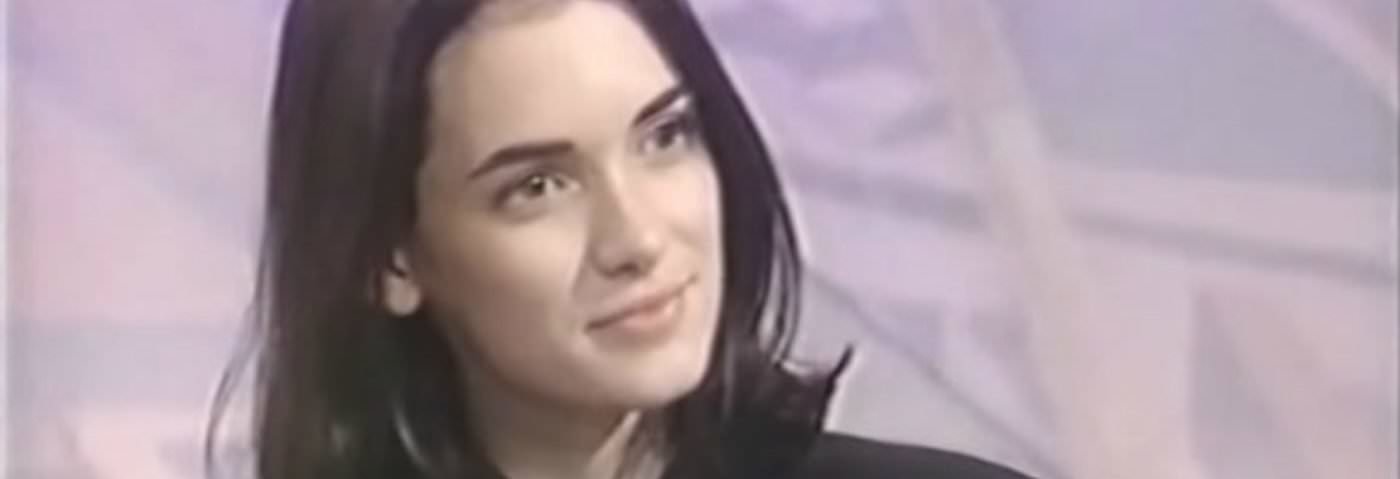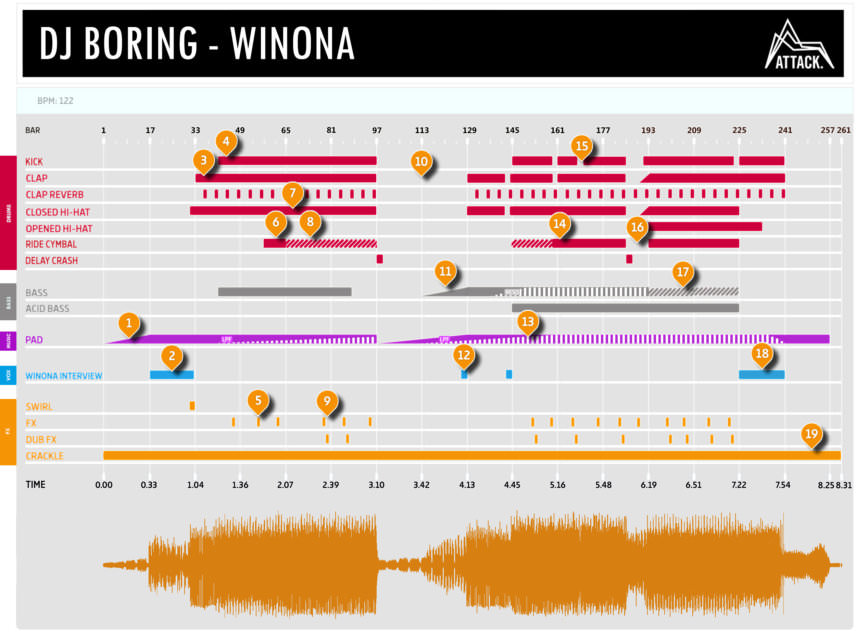DJ Boring’s ‘Winona’ is an archetypal lo-fi house production. We deconstruct it to find out what makes the mix work.
In the Deconstructed series, we analyse the arrangements of tracks to see what we can learn from their structure. DJ Boring’s ‘Winona’ was one of the breakthrough tracks from the nascent lo-fi house scene, fusing deep house elements with raw aesthetics and vintage sound processing. It’s a deceptively simple formula which proves incredibly effective.
The Track
THE ARRANGEMENT
(Click to enlarge.)
WHAT’S HAPPENING?
- The track opens with a synth pad accompanied by a vinyl crackle. The volume is automated, slowly drawing the listener into the ambient atmosphere. The chord is a minor 9, which moves from C to F repetitively. We discussed the use of typical minor 7 chords found in deep house and the jazzier minor 9 chords in previous articles.
- The vocal used is a sample from a 1999 interview with American actress Winona Ryder, best known for her roles in Edward Scissor Hands and more recently Stranger Things. The vocal sample holds a lo-fi quality which matches the vibe that has already been established. The synth continues to build gradually in volume, increasing tension in a subtle manner.
- The vocal ends, but is layered with an effect which has a delay with a long feedback. This technique is used to bridge different sections of songs and aid the transition. A sampled hi-hat and clap are introduced, with a crunchy reverb added to the hi-hat and sporadic second clap to push them further into the back of the mix.
- A thumping kick drum takes over, still accompanied by the synth pad and percussive elements. The kick has been processed with distortion, giving it an almost broken quality. The track relies heavily on the kick to provide weight in the low frequencies. A bassy ‘whoomp’ is also added in between kicks to add groove to the low-end rhythm.
- At points in the track we hear a bitcrushed laser effect, used to add variation and some energy to the high frequency part of the spectrum. It is added infrequently, surprising the listener and helping to sustain their interest in the progression of the record.
- A ride cymbal with heavy sidechain compression is added. This is a classic technique used by house and techno producers to increase the energy of a track. Instruments containing high frequencies are a great way to progress the song in a simple way without complicating the record or compromising the focus of the other instruments. At this point there is also a slight variation in the kick, with an extra couple of hits on the off beat.
- Just prior to this new section the kick and ride cymbal cut out simultaneously. The decay of the ride cymbal bleeds into the emptier section before reintroducing itself in the same rhythm as the off-beat hi-hat.
- The ride cymbal’s original decay is shortened considerably, delivering a punchier and tighter sound. The layer sits attractively with the hi-hat part. Some very short closed hi-hats are added in between the other hats. The kick continues to play different rhythmic variations.
- A dub-like siren sound is added here for a little more variation. In minimal tracks such as this, occasional changes in sound selection are essential to maintain the listener’s interest. Sometimes, its these arbitrary moments that add magic to potentially monotonous repetition of synths, basslines and drum parts.
- The track loses the drums, bass and kick to signal the arrival of the breakdown. A delayed crash cymbal aids the transition. The synth builds ever so subtly again with volume automation.
- It’s not immediately obvious exactly what’s being introduced as the breakdown ends, but the knock-like sound is clearly a new instrument. The low-pass filter on the synth is closed so that only a few frequencies pop through. An envelope filter with a fast attack and short decay emphasises the initial frequencies produced by the synth. As this section progresses, the filter continues to open and we real that we now have a TB-303-style acid bass sound. The new sound provides an essential variation for the second half of the track and a solid low end which will add movement to the groove.
- Winona’s voice makes a cameo appearance before the reintroduction of the hats and clap. They are introduced in a similar fashion to the beginning of the track, allowing the listener to anticipate the full beat. The resonance on the new synth is increased, giving a classic squelchy acid bassline tone.
- Again we hear Winona’s voice at the end of the section before dropping into the full beat with the drums, kick and bass. The original pad synth is louder than before and has also had some automation added to the low-pass filter.
- The ride cymbal returns but this time with more reverb, pushing it further into the back of the mix. The reverb adds ambience but also helps ensure the cymbal doesn’t interfere with the acid bass, which continues to be automated for variation.
- The acid bassline plays by itself for a moment here with an added delay effect on the first two notes. The kick drops out to give it space, almost making it feel like the record is skipping. It then unexpectedly drops back in after two beats.
- We come to a short breakdown, retaining the bass sound momentarily as other elements cut out. The acid bassline has a delay added to it, allowing it to drop out smoothly. As the delay fades out, some swung 16th-note hats fade in, replacing the rhythmic space taken up by the acid bassline synth. Switching between instruments can be tricky, as when one is taken out the producer is often faced with having to fill the space. By using very prevalent and constant hi-hats, the producer is able to divert the listener’s attention to the new instrument without having to worry about losing concentration. The rolling hats also add a new progression.
- The acid bassline is reintroduced with a new single note and less frequent rhythm. The filter is also brought down so that it sits further in the background. The synth pad and rolling hats dominate this section with their prominent high frequencies. This final energy peak is achieved simply by using all previous elements of the track simultaneously.
- The acid bassline and rolling hats drop out to lower the energy and make space for Winona’s vocal sample one last time. Her voice playing over all the elements would have overwhelmed the mix, but more importantly this signals the beginning of the end of the track. The kick, clap and pad synth play out for a final 16 bars to allow the DJ time to mix out the record.
- The synth pad automates down in volume and filter in the opposite fashion as to which it entered the track.
online pharmacy buy cialis-super-active no prescription pharmacy


08.32 AM
Nice one, cheers guys